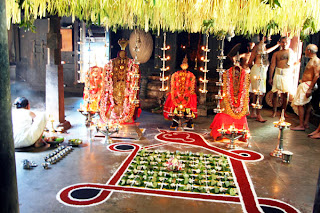Mannadi, a small village in the Kollam district of Kerala is
quite often identified with the famous patriot and the freedom fighter
Veluthampi Dalava. It is here he committed suicide after a humiliating defeat
at the hands of the British army. The village is being visited by hundreds of
people and most of the visitors are devotees of Goddess kali at Mannadi Temple
known as Mannadi Kavu.
 |
| Mannadi Kavu |
The shrine here is believed to be highly powerful and will
realize all your wishes if you pray with dedication and sincerity. There is a
legend behind the temple.
The entire area was once under the rule of a Brahmin feudal
lord known as ‘Vakkuvanjipuzha Pandarathil’. He maintained a private army to
protect the land and other properties belong to him and the commander was one ‘Paniker’.
Panicker used to stay in the same village and surrounding three sides of his
house was a dense forest. Once, the labors of Panicker were clearing the forest
to make it cultivable land. When a lady among them rubbed her sickle on a rock
to sharpen it, blood oozed out of it. Seeing that the lady fainted and others
rushed to Panicker to inform him about the incident.
Hearing the whole story Panicker rushed to his master,
Pandarathil and informed him. Being a Brahmin scholar he understood that the blood
from the rock indicates the presence of divine power on that rock. He
instructed Panicker to get some bananas and boiled paddy to the spot by the
time he arrives there. Panicker did the same. When the Pandarathil was about to
offer those bananas and boiled paddy, a tribal man came therefrom within the
forest and asked Pandarathil not to perform the ritual. He told that it is the
divine power of Kali speaking from within himself and she did not want any type
of rituals by Brahmins. She instructed Pandarathil to keep the food articles
there for quite some time and then to take it back.
However, most of the people gathered there did not believe
his words. They thought that it is the Panicker who is making this tribal man speak so. Sensing the situation, the tribal man got angry. He shouted at the
gathering’
“Don’t you believe me? Then I will show you who I Am.” Saying
this, he ran into the forest. Some enthusiastic youth also followed him. Deep
inside the forest, there is a hill lock and the top of it there is a rock with
the shape of an umbrella. It is called in the local language as “Kuda Para”. It
is quite impossible for an ordinary man to climb on that rock, but this tribal
man climbed over the rock and descended three times very easily. Then he went
further inside the forest and came out riding on a tiger. Seeing this people
got convinced that it is not the tribal man, but the divine power of Kali is
speaking from inside him.
Pandarathil, being a devotee of Maa Kali, built a temple
there and started worshiping her. However, he was sad as he did not have a
child. One day the old tribal man appeared in front of him and asked to pledge
that he will offer a bunch of golden hairs to Kali if he is blessed with a son.
He agreed and promised the same. To everyone’s surprise, Pandarathil’s wife
delivered a son within a year and as promised he offered a bunch of golden
hairs, which is still kept inside the temple and will display on special occasions.
 |
| Kambithan |
The tribal man went missing after this incident and people
were very sad as they could hear the words of the goddess through him. One day he
appeared in front of Pandarathil and asked him not to worry as they will get a
new oracle. After a few days, a man with a long beard and hair appeared in that
village. He sat beneath a huge tree near the temple. Suddenly he jumped from
there and started uttering something histrionic. When people gathered there he
too went inside the forest and climbed on the Kuda Para and then came out
riding on a tiger. People approved him as the new oracle through whom the goddess
speaks and started calling him kambithan.
During this Kambithan’s period, the King of Madurai offered
to present Golden Crown to the idol if the Kambithan comes directly there.
Although he decided it he did not mention it to anybody. One fine morning
the Kambithan started shivering and he told the devotees that he had to leave
the village as some devotees offered something. On that night just before going
to sleep, the King of Madurai saw the Kambithan in his bedroom. Kambithan asked
the King to give whatever he had offered.
King handed over a crown of sliver to him. This made
Kambithan angry. He shouted that either the King should give what he promised
or should be ready to face the consequences. Fearing the wrath of Goddess, the
king handed over the golden crown which is still at the temple.
 |
| Mannadi |
After the death of this Kambithan, the temple authorities
deposited the sword used by the Kambithan at a deep place in the nearby river. After
quite some time another person came there and repeated whatever the earlier
Kambithan did and dived into the river and came out with the sword. He became
the next Kambithan.
Presently there is no Kambithan there in Mannadi Kavu. The divine sword is resting beneath the water waiting for another Kambithan.













